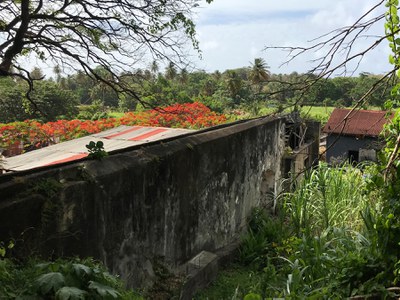Treasure Hunter Discovers Pesticide
If you could go on a treasure hunt, what would you search for?
Would you search for gold? Precious jewels? Dinosaur bones?
John Mynderse searched for a different type of treasure. He was a chemist who loved to collect soil from odd places, hoping to discover pharmaceutical chemicals to fight human diseases.
In 1982, John was enjoying his vacation with his family in the Caribbean. They laid on the sandy beach and relaxed in the warm sun.
But then swarms of bugs started to attack them. They swatted away the bugs, packed up their stuff, and moved to a new spot on the beach.
This new spot was much better. The bugs were surprisingly gone!
After a few moments relaxing in the new location, John’s scientific curiosity took over. He began to wonder why there were fewer bugs on this part of the beach.
John took a walk around the area and saw an abandoned rum distillery similar to one shown in the photo.
Time to dig for treasure!
He took soil samples from the distillery and brought them to his lab. There he discovered unknown chemicals produced by a microbe in crushed sugar cane. The product was named spinosad.
Several years of medical and agricultural testing revealed spinosad would kill insects that touched or ate it. The muscles of an insect would flex uncontrollably, leading to paralysis and death within two days.
Since its release in 1997, spinosad has protected crops against beetles, caterpillars, flies, ants, grasshoppers, mites, thrips, mosquitoes and slugs. It is available to gardeners in numerous products including Entrust, Captain Jack’s Dead Bug Brew, and Monterey Garden Insect Spray.
This organic pesticide is low in toxicity and much safer to humans compared to the common synthetic chemical insecticides sold at garden centers. The Environmental Protection Agency has detected no link of spinosad to cancer.
Spinosad is very toxic to honey bees, but evidence suggests it has little or no effect on honey bees and bene-ficial insects after sprays have dried.
You can prevent harming bees by spraying any blooming plants in the evening when bees are not active. The first 3 hours after spraying are critical.
Spinosad breaks down rapidly in sunlight. Most vegetables can be safely harvested from the garden 1 to 3 days after being sprayed.
Spinosad has become one of the safest, most effective pesticides in organic gardening. John Mynderse, the curious chemist, discovered a great treasure in the Caribbean.
Written by Tom Kalb, Extension Horticulturist, North Dakota State University.
Sources:
Bunch, T. R.; C. Bond, K. Buhl, and D. Stone 2014. Spinosad general fact sheet; National Pesticide Information Center, Oregon State University Extension Services. http://npic.orst.edu/factsheets/spinosadgen.html.
Hertlein, M.B, J. McNelly and G. Thompson. Spring 2011. Spinosad: An exciting new product for larval control. Wing Beats Newsletter, University of Florida. https://pested.ifas.ufl.edu/pdfs/spinosad_history.pdforida.
Trifexis. 2019. The story of spinosad. YouTube. https://www.youtube.com/watch?v=7866pqzY0jY
Wikipedia. Spinosad. https://en.wikipedia.org/wiki/Spinosad. Accessed July 31, 2021.
The photo courtesy of Heather Cowper, www.heatheronhertravels.com.


